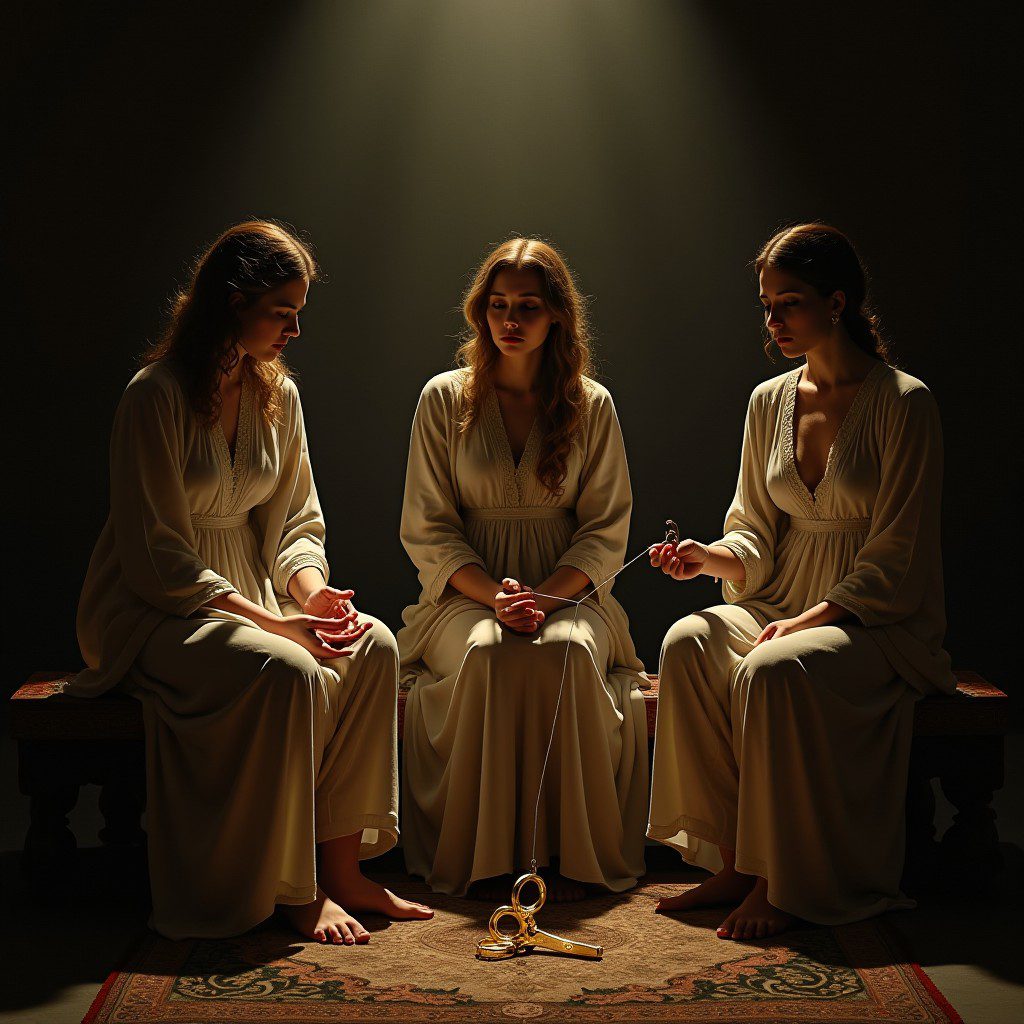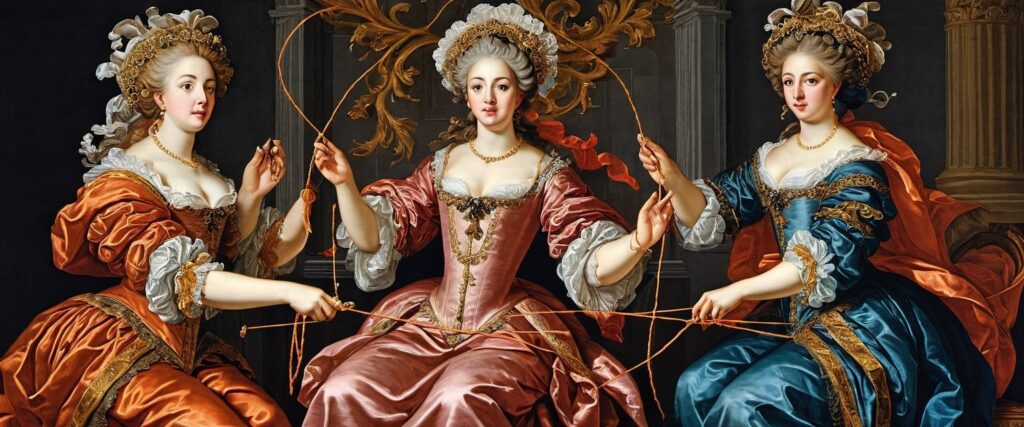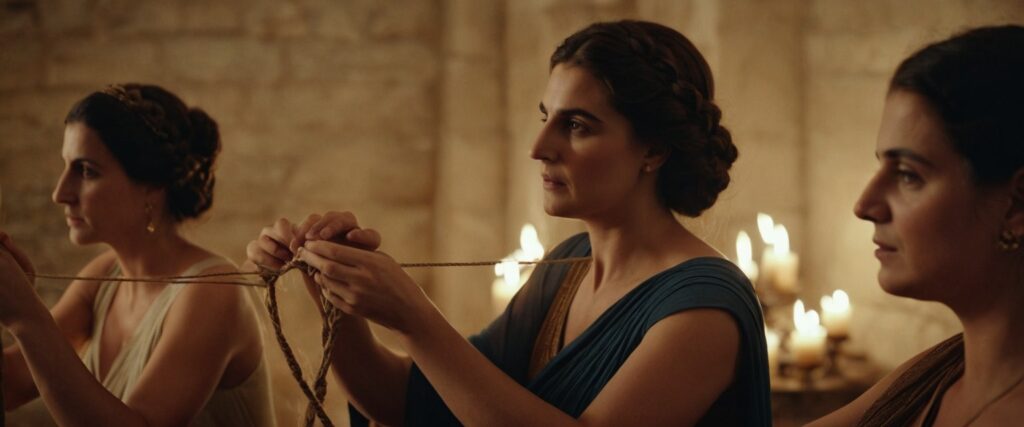The Greek Fates: The Weavers of Destiny

The Fates, known as the Moirai in Greek mythology, are among the most powerful and revered deities in the pantheon. These three sisters—Clotho, Lachesis, and Atropos—hold dominion over the fate of every mortal and god, weaving the threads of life and controlling the destinies of all. Though they do not command the grand elements of the universe like Zeus or Poseidon, their authority is perhaps greater, as even the mightiest Olympian gods are subject to the destiny the Fates spin.
The Fates embody the Greek concept of moira, meaning “lot” or “share,” which is the idea that everyone has an allotted fate from birth to death. The Fates ensure that this portion is assigned and fulfilled, making them pivotal figures in Greek religion and culture. Their role in myth is as complex as it is final, representing the unchangeable nature of destiny.
Origins and Cultural History of the Fates
The Moirai are often considered the daughters of the primordial goddess Nyx (Night) or, in some accounts, Zeus and Themis, the goddess of divine order and law. The duality of their parentage highlights their role as enforcers of cosmic law—above even the gods themselves. The Greek concept of moira (fate) was one of the most fundamental beliefs of the ancient world, representing the unavoidable flow of life, death, and everything in between.
While their role as controllers of fate is consistent, the Moirai are rarely seen as vengeful or malevolent forces. Instead, they are neutral, unemotional enforcers of natural law. They do not actively seek to punish or reward; they simply ensure that each person’s destiny is fulfilled. In this way, they reflect the Greek belief in a cosmos that, while influenced by gods and heroes, ultimately follows an unchangeable order.
The Three Sisters: Clotho, Lachesis, and Atropos

Each of the three Moirai has a distinct role in the weaving of fate, representing the different stages of life:
1. Clotho (The Spinner)
Clotho is the Fate who spins the thread of life. She is often depicted as the youngest of the three sisters, and her role is to create the thread that represents each individual’s life. This thread, once spun, sets the course of a person’s existence. Clotho’s spinning symbolizes birth, growth, and potential, but also the fragile nature of life.
In some myths, Clotho is also said to have intervened in key moments of Greek myth. For example, she is credited with spinning the thread of life for gods and heroes, including restoring Pelops to life after his father Tantalus killed and served him to the gods.
2. Lachesis (The Allotter)
Lachesis measures the thread of life spun by Clotho. Her role is to determine the length of each person’s life, deciding how long they will live and what their experiences will be. She is the weaver of destiny’s course, allotting the joys, sorrows, and events that will define an individual’s life.
Lachesis’ role reflects the idea that life’s experiences are part of a preordained design. Mortals may make choices, but Lachesis has already set the pattern of life events, showing that free will operates within the boundaries of fate.
3. Atropos (The Inflexible)
Atropos is the oldest and most feared of the three sisters. Her role is to cut the thread of life when the time has come for a person to die. Her name, meaning “inflexible” or “inevitable,” perfectly describes her role in the mythological world. She is often depicted carrying shears or scissors, and once she cuts the thread, death is irreversible.
Atropos symbolizes the finality of death and the idea that no one can escape their ultimate fate, no matter how powerful they are. Her role also ties into the ancient belief that life is fragile, and death can come at any moment, without warning.
The Fates in Ancient Literature
The Fates appear in some of the most important works of ancient Greek literature. In Hesiod’s Theogony, the Fates are described as daughters of Nyx, but they are also sometimes considered daughters of Zeus and Themis in later accounts. In this text, the Moirai are given the role of deciding the fate of both mortals and gods, showing their universal authority.
The Iliad and the Odyssey, both attributed to Homer, also mention the Fates. In The Iliad, even Zeus, the king of the gods, is shown to respect the decisions of the Moirai. He considers intervening to save his son Sarpedon from death in battle but ultimately allows the Fates to dictate the outcome, demonstrating that not even the gods can alter what has been spun.
Aeschylus, in his Oresteia trilogy, uses the Fates as a metaphor for justice and the inescapable nature of guilt. The Fates’ presence looms over the characters, particularly Orestes, who is caught in a cycle of familial vengeance. Similarly, Sophocles’ Oedipus Rex is a direct exploration of fate versus free will, with the protagonist Oedipus attempting to escape the destiny that the Moirai have laid out for him—only to fall into it.
Strengths and Weaknesses of the Fates
Strengths:

- Ultimate Power Over Life and Death: The Fates control every aspect of a mortal’s existence, from birth to death. Their power is absolute, and not even the gods can alter the destinies they weave.
- Impartiality: The Fates are neutral figures who do not favor mortals or gods. They are simply the weavers of destiny, unaffected by personal bias or emotions. This impartiality gives them an unshakable authority in myth.
- Cosmic Order: The Fates are fundamental to maintaining the balance of the universe. Their work ensures that life follows a predictable, ordered flow, preventing chaos from overwhelming the world. Their function underscores the Greek belief in a cosmos ruled by reason, even if it sometimes seems cruel.
Weaknesses:
- Unyielding Nature: Their greatest strength is also their greatest weakness. The inflexibility of fate means that there is no room for mercy or second chances. This lack of compassion can be seen as a flaw, as even good and noble figures are subject to their harsh rule.
- Feared by All, Loved by Few: The Fates are rarely worshipped in the way other gods and goddesses are, largely because they inspire fear rather than reverence. They are not approachable deities, and their work is often seen as cold and detached from the struggles of mortals.
- Bound to Destiny: While the Fates control destiny, they are also bound by it. They cannot alter the course they themselves set, and this lack of flexibility may suggest that even they are constrained by the cosmic laws they enforce.
The Fates in Modern Media
The Moirai have continued to inspire modern interpretations in literature, television, film, and video games, often serving as symbols of destiny, fate, and the inescapable nature of death.
- Literature:
- The Fates appear in Rick Riordan’s Percy Jackson & the Olympians series, where they are depicted as formidable and somewhat eerie figures, maintaining their role as guardians of destiny. They appear early in the series, reminding Percy that his fate is already set.
- In Neil Gaiman’s The Sandman comics, the Fates, known as the “Three,” play a recurring role as wise, yet cryptic figures who hold knowledge of destiny, much like their Greek counterparts.
- Television and Film:
- In Disney’s Hercules (1997), the Fates are reimagined as three comical, yet sinister, elderly women who share a single eye, inspired by the Graeae (a different trio of mythological sisters). Despite the comedic portrayal, they remain in control of life and death, cutting the threads of mortals’ lives with their scissors.
- In Clash of the Titans (2010), the Moirai are depicted as eerie, otherworldly beings, echoing their mythological role as controllers of fate, consulted by the heroes to understand their destinies.
- Video Games:
- In Hades (2020), the Fates are referenced as the ultimate forces of destiny, and the game’s roguelike structure plays into the concept of repeating cycles of death and rebirth—mirroring the unchangeable nature of fate in Greek mythology.
- In God of War (2018), the Norse equivalent of the Fates, the Norns, feature prominently, but their role is heavily inspired by the Greek concept of inescapable destiny, showing how intertwined ideas of fate are across different mythologies.
The Fates: Weaving the Threads of Life and Death
The Fates represent one of the most profound aspects of Greek mythology: the inevitability of destiny. While they are often viewed as distant and unemotional figures, their role in myth is essential for understanding how the ancient Greeks saw the world. For them, life was governed by an intricate and unchangeable web of fate, which even the gods had to respect.
The Moirai are symbols of both life’s fragility and the cosmic order that keeps the universe running. From the beginning
of life, spun by Clotho, to its allocation by Lachesis, and finally its end at the hands of Atropos, the Fates show that life’s path, though full of twists and turns, is ultimately unchangeable. They remain powerful symbols of the enduring, often harsh, truth that no one, not even the gods, can escape their destiny.
